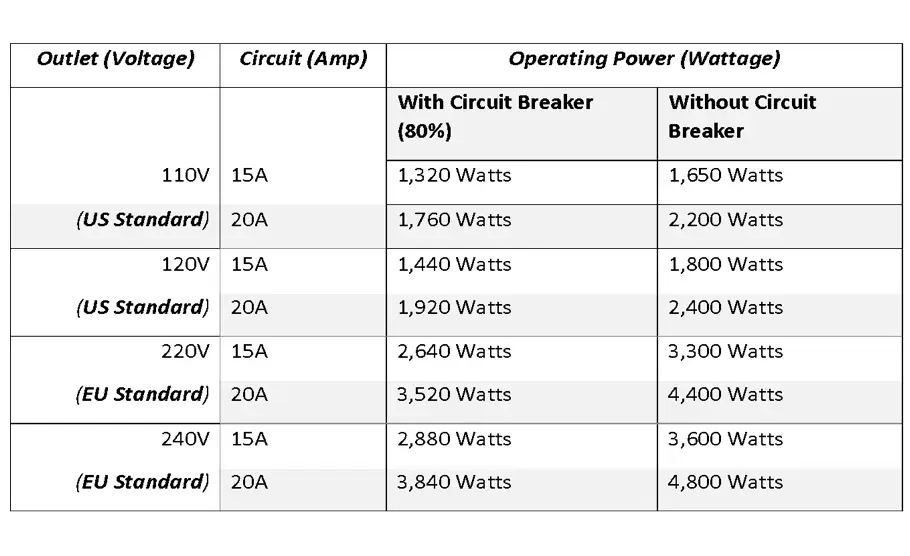Ever wondered about the hidden power of your home’s electrical system? You might have a standard 120V outlet powering your everyday devices, but there’s a more potent force lurking behind certain appliances – the 240V outlet. This powerhouse, often found in kitchens, garages, and laundry rooms, is designed to handle the demands of high-wattage appliances. But just how much power can it deliver?

Image: wiringsolver.com
Understanding the capabilities of a 240V outlet is crucial for ensuring safe and efficient appliance operation. This article dives deep into the world of electrical outlets, deciphering the mysteries behind wattage, amperage, and the vital role of circuit breakers in safeguarding your home.
The Basics of Electricity: Watts, Amps, and Voltage
To understand how much power a 240V outlet can handle, we need to unravel the fundamental principles of electricity. Three key concepts are at play:
- Voltage (V): The electrical “pressure” that drives electrons through a circuit. It’s a measure of the potential difference between two points. A 240V outlet has a higher voltage than a standard 120V outlet.
- Amperage (A): The rate of flow of electrical current, measured in amperes. It represents the amount of electrical charge passing a point in a circuit per unit of time.
- Wattage (W): The power of an electrical device, which is the rate at which it uses energy. It’s calculated by multiplying voltage and amperage (Watts = Volts x Amps).
The Power of 240V: Unveiling the Potential
A 240V outlet, commonly found in North America and other countries, is designed to handle a higher wattage than its 120V counterpart. This ability is crucial for powering heavy-duty appliances like:
- Electric Ovens and Ranges: These kitchen workhorses often consume considerable power for heating elements and broilers.
- Water Heaters: Electric water heaters require significant wattage to raise the temperature of water for showers and other household needs.
- Clothes Dryers: Electric dryers utilize high wattage to efficiently dry clothes, particularly in large quantities.
- Electric Vehicle Chargers: As electric vehicle adoption grows, 240V outlets are becoming increasingly important for charging these vehicles efficiently.
Unraveling the Wattage Mystery: A Deep Dive
The maximum wattage a 240V outlet can handle is determined by the amperage rating of the circuit it’s connected to. Here’s a breakdown:

Image: homienjoy.com
The Role of Circuit Breakers
Each electrical circuit in your home is protected by a circuit breaker, a safety device that interrupts the flow of current if it exceeds a certain level. The amperage rating of the circuit breaker is directly related to the maximum wattage the circuit can handle.
Common Circuit Breaker Ratings
Common 240V circuit breaker ratings and their corresponding maximum wattages:
- 15 Amp Circuit Breaker: 3,600 watts (15 amps x 240 volts = 3,600 watts)
- 20 Amp Circuit Breaker: 4,800 watts (20 amps x 240 volts = 4,800 watts)
- 30 Amp Circuit Breaker: 7,200 watts (30 amps x 240 volts = 7,200 watts)
- 40 Amp Circuit Breaker: 9,600 watts (40 amps x 240 volts = 9,600 watts)
- 50 Amp Circuit Breaker: 12,000 watts (50 amps x 240 volts = 12,000 watts)
It’s crucial to understand that these wattage figures represent the **maximum** safe limit for the circuit. It’s generally advisable to leave some headroom to prevent overloading the circuit and causing potential electrical hazards.
Understanding Wattage and Appliance Labels
Every electrical appliance is equipped with a label that lists its voltage and wattage requirements. This information is essential for determining the appropriate circuit and outlet for safe operation.
When choosing an outlet or circuit for an appliance, always select one with a wattage rating exceeding the appliance’s needs. This ensures the circuit can handle the appliance’s power demands without overloading.
Safety First: Preventing Electrical Hazards
Electrical safety is paramount, especially when working with high-voltage circuits. Here are some essential precautions to keep in mind:
- Professional Installation: If you’re unsure about the wiring, always consult a licensed electrician for professional installation of 240V outlets and circuits.
- Avoid Overloading: Never connect multiple high-wattage appliances to the same 240V circuit, as this can lead to overheating and potential fire hazards.
- Regular Inspection: Periodically inspect 240V outlets and circuits for any signs of damage or wear. Replace any faulty components promptly.
- Proper Wiring: Ensure all connections are securely made with the correct gauge wire for the circuit’s amperage rating.
The Future of 240V: Electric Vehicles and Beyond
As the world shifts towards clean energy, the demand for 240V outlets is expected to surge. Electric vehicle charging requires significant power, making 240V outlets essential for fast and efficient charging. This increasing demand is likely to drive advancements in outlet technology and circuit design, ensuring safe and reliable power delivery for both current and future applications.
How Many Watts Can A 240v Outlet Handle
Conclusion: A Powerful Force for Your Home
A 240V outlet is more than just a simple electrical connection; it’s a gateway to harnessing significant power for high-wattage appliances and technological advancements. By understanding its capabilities, the importance of circuit breakers, and the wattage needs of appliances, you can ensure safe and efficient operation of your appliances while maximizing the potential of this powerful electrical resource.
Remember, electrical safety should always come first. If you have any doubts or need assistance with electrical work, don’t hesitate to contact a qualified electrician. With proper knowledge and responsible use, you can unleash the power of your 240V outlets and make the most of the electrical energy that powers your home.





